
- Source: THE NEW YORK TIMES
- Author: HOLLAND COTTER
- Date: MAY 16, 2019
- Format: DIGITAL
The Whitney Biennial: Young Art Cross-Stitched With Politics
The look is personal, the message quietly topical.
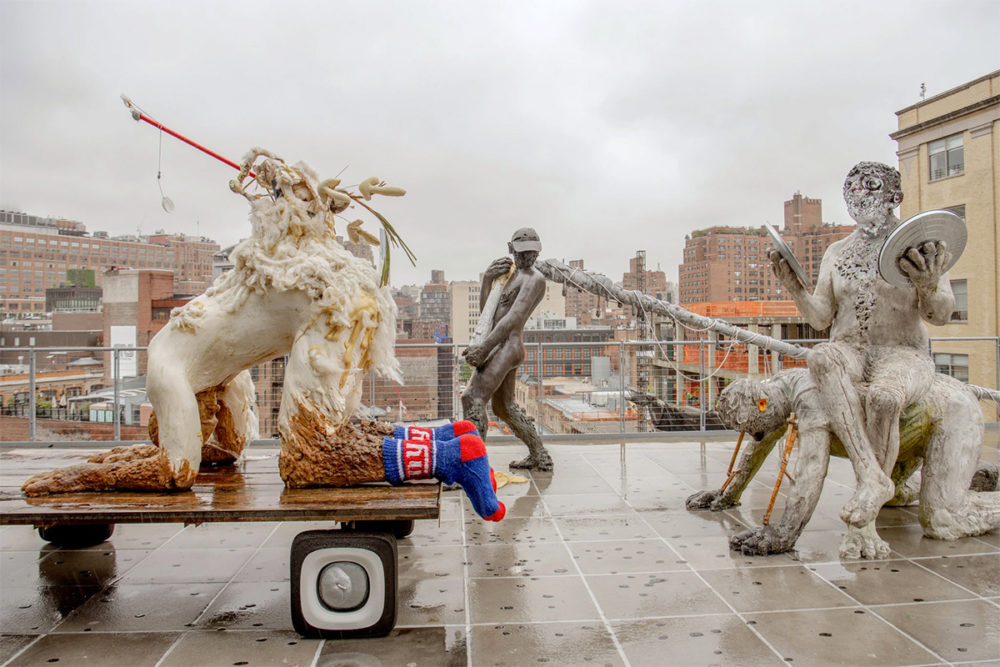
Nicole Eisenman’s “Procession” (2019) is a rare spectacle in the Whitney Museum’s Biennial. Installed on the sixth-floor terrace, its lurching figures, Holland Cotter writes, “embody the exhibition’s history-conjuring, identity-expanding, form-scrambling tendencies.” Vincent Tullo for The New York Times
Given the political tensions that have sent spasms through the nation over the past two years, you might have expected — hoped — that the 2019 Whitney Biennial would be one big, sharp Occupy-style yawp. It isn’t. Politics are present, but with a few notable exceptions, murmured, coded, stitched into the weave of fastidiously form-conscious, labor-intensive work.
As a result, the exhibition, organized by two young Whitney curators, Rujeko Hockley and Jane Panetta, gives the initial impression of being a well-groomed group show rather than a statement of resistance. Yet once you start looking closely, the impression changes. Artist by artist, piece by piece, there’s a lot of quiet agitation in the air.
And the basics are strong. Demographically, the show — which fills the museum’s fifth and sixth floors, spreads down to the third, into the lobby, and out to the street — adheres to what seems to have become a new Whitney norm: namely, a view of American art far more inclusive than it once was.
The 75 participants include artists hailing from Canada and Puerto Rico and non-coastal points in between, as well as several born in Africa and Asia and at least a few United States citizens living abroad. The ethnic and gender mix is balanced to a degree unimaginable even a decade ago. And it’s a young show: three quarters of the artists are under 40, with 20 of them under 33. So that’s all good.
Quiet Agitation
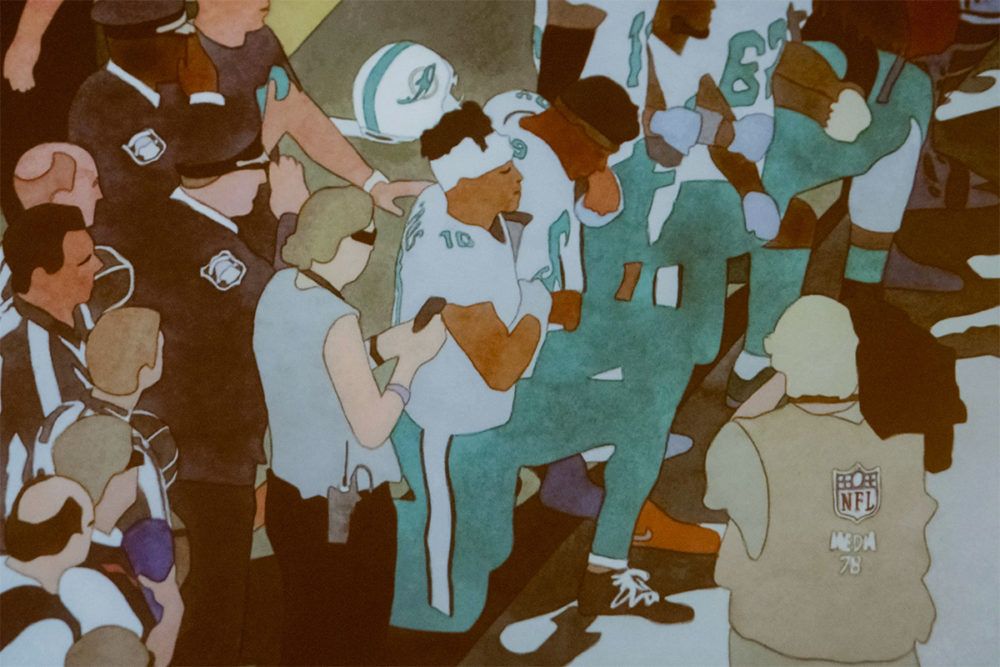
A scene from Kota Ezawa’s 2018 video “National Anthem,” depicting N.F.L. players taking a pregame knee to protest police violence against African-American men and women. Vincent Tullo for The New York Times
Topical politics, present, if low-keyed, begin at the fifth-floor elevator, where you’re greeted by soft, melancholic instrumental music that takes a minute to place: It’s a largo version of “The Star-Spangled Banner,” which is also the soundtrack of a video animation by the German-born, California-based Kota Ezawa depicting N.F.L. players taking a pregame knee to protest police violence against African-American men and women.
Nearby hang a set of nine photographic prints by the Brooklyn artist Josh Kline, each encased in a boxy metal frame. The pictures, dyed lurid oranges, greens and violets, encompass shots of a statue of Ronald Reagan in the United States Capitol Rotunda in Washington, the reception desk at Twitter headquarters in San Francisco and the exterior of a Park Avenue high rise. Within each frame, water, fed by pumps, is rising, like climate denial payback in progress. Reagan can barely keep his head above the flood.
And while the current occupant of the White House goes undepicted in the show, he’s very much part of a powerful new work by Alexandra Bell. It’s made up of 20 prints reproducing pages of New York City newspapers dating from the time of the Central Park jogger case in 1989, when a group of black and Latino teenagers were convicted and imprisoned — falsely, it turned out — for assaulting and raping a white woman.
Ms. Bell edits the pages to stress the undisguised hostility of the press to the defendants, and she punctuates the series with a full-page advertisement taken out in The New York Times, The New York Post, The Daily News and New York Newsday. Its headline reads, “Bring Back the Death Penalty.” It was placed and paid for by Donald J. Trump.
The show’s only other example of what might be termed hard politics is a 10-minute video called “Triple-Chaser” by the London-based activist collective Forensic Architecture. The piece was made specifically for the Biennial and addressed to a controversy in which the Whitney is now deeply embroiled: a demand by protesters that one of its trustees, Warren B. Kanders, founder of a company, Safariland, that produces police and military weaponry, leave the board. (Both Ms. Hockley and Ms. Panetta signed a staff petition to that effect. Nearly half the Biennial artists signed another one.)
A Triple-Chaser is a type of tear gas grenade manufactured by Safariland that has allegedly been used against civilians at the U.S.-Mexico border and elsewhere. The video, narrated by the musician David Byrne and proposing a digital method for tracking use of the tear gas, has the pulse-pushing tone and pace of effective agitprop. It gives a show otherwise geared to slow reading a jolt of real-time sizzle, and — importantly — it calls attention to the institutional framework in which the reading is taking place. (As of this writing, Mr. Kanders is still on the board.)
This is not to say that other work doesn’t deal with in-the-now issues. Eddie Arroyo’s small paintings of houses and shops in the Little Haiti section of his hometown, Miami, is both a homage to, and a lament for, a place and way of life being erased by gentrification. And embedded in otherwise abstract collage-paintings by Tomashi Jackson are references to the seizure of African-American property in New York City, from the 19th century onward, in the interest of urban “renewal.”
Beyond ‘Identity Art’
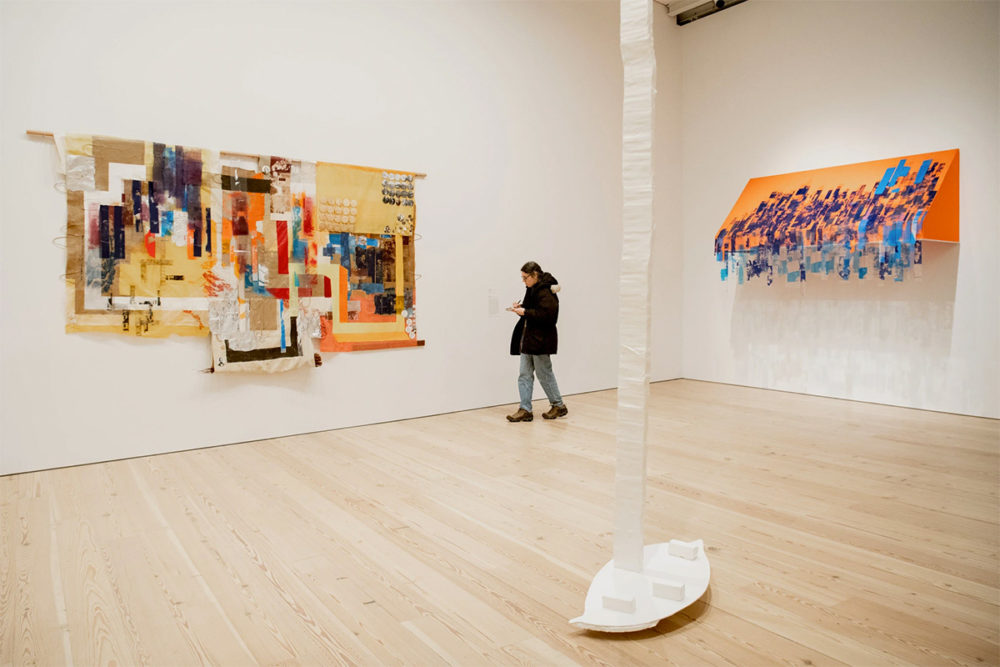
Tomashi Jackson’s “Hometown Buffet-Two Blues (Limited Value Exercise),” left, and “Third Party Transfer and the Making of Central Park (Seneca Village — Brooklyn 1853-2019),” right, are as much about abstraction as racial politics. Olga Balema’s Styrofoam “Leaf” is at center. Vincent Tullo for The New York Times
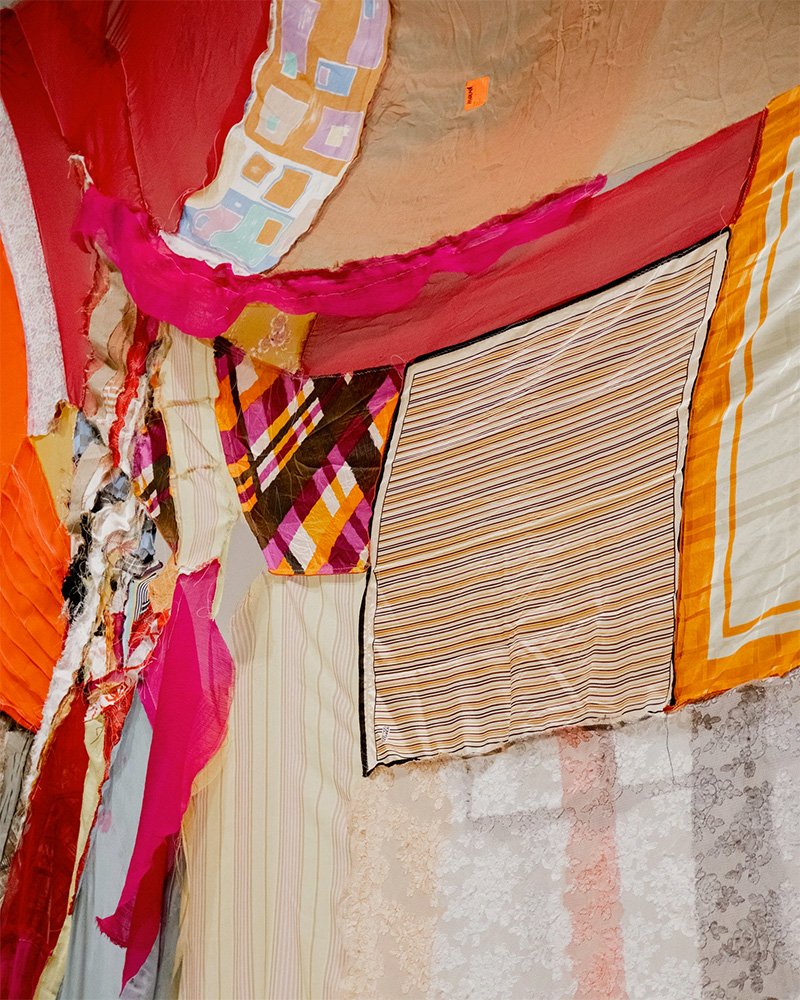
A detail of Eric N. Mack’s “Proposition: for wet Gee’s Bend Quilts to replace the American flag — Permanently,” 2019. Vincent Tullo for The New York Times
Ms. Jackson’s work suggests ways in which the category called “identity art” is still evolving. Her art is as much about abstraction as it is about racial politics. The same is true of Eric N. Mack’s gorgeous free-hanging fabric piece titled “Proposition: for wet Gee’s Bend Quilts to replace the American flag — Permanently,” and his painting-and-text shout-out to the African-American artist Alvin Baltrop (1948-2004), who, in the 1970s, photographed the gay “sex piers” that once lined the Hudson River across from where the Whitney now stands.
And, whether intended or not, this Biennial holds what amounts to a mini-update on the era-shaping 1994 Whitney survey “Black Male: Representations of Masculinity in Contemporary Art.” Taken together, the photographs of John Edmonds and Paul Mpagi Sepuya, the photo-collages of Todd Gray and Troy Michie, and the sculptures of Joe Minter and Matthew Angelo Harrison, comprise a digest of developments in the visual examination of race and genre brilliantly set out by then-Whitney curator Thelma Golden a quarter century ago.
The work of these six, very different artists suggests a 21st-century trend away images of victimhood toward those of agency, which is not necessarily the same thing as old-time Black Power. You find this dynamic, too, in Steffani Jemison’s video of a galvanic performance by the Reverend Susan Webb, Christian minister and master mime, and in a mural-scale canvas by Janiva Ellis that fuses Afro-futurist fantasy with history painting.
That trend extends to the art of Native American artists like Jeffrey Gibson, who brings examples of fabulous rainbow-colored unisex powwow gear, and suspends them on high like banners. And to a luminous music video by Apache artist Laura Ortman, in which primal nature (stereotypically associated with “native” America) and contemporary culture (represented by Ms. Ortman’s violin score and a cameo turn by the great New York City Ballet dancer Jock Soto, of Apache and Puerto Rican descent) are one.
By rethinking culture, Ms. Ortman reclaims and revivifies history. Gala Porras-Kim does this, too, in her non-linguistic approach to accessing inscriptions — the spirit of them, not the letter — on a single pre-Columbian stele. So does Ilana Harris-Babou who, in a video, casts a sardonic eye on the too-easy Western consumption of the Middle Passage by recasting Gorée Island in Senegal, once a departure point for the trans-Atlantic slave trade, as a contemporary lifestyle destination.
And in a truly extraordinary video triptych, Ellie Ga, an American artist living in Sweden, weaves together archaeology, oceanography and social justice by recording the recovery of ancient remains from the Aegean, the tidal drift of Japanese tsunami debris to the Greek islands and the arrival of asylum seekers and refugees to those same islands. Circulating throughout all of this is an account of her being unmoored by grief at the death of her parents. Each part of the triptych runs about 13 minutes; all three reward watching, start to finish.
Renegotiating History

Three of Gala Porras-Kim’s works in the biennial, a mix of sculpture and works on paper, include, from left: “La Mojarra Stela and its shapes,” “La Mojarra Stela negative space” and “La Mojarra Stela illuminated text,” all from 2019. Vincent Tullo for The New York Times
By rethinking culture, Ms. Ortman reclaims and revivifies history. Gala Porras-Kim does this, too, in her non-linguistic approach to accessing inscriptions — the spirit of them, not the letter — on a single pre-Columbian stele. So does Ilana Harris-Babou who, in a video, casts a sardonic eye on the too-easy Western consumption of the Middle Passage by recasting Gorée Island in Senegal, once a departure point for the trans-Atlantic slave trade, as a contemporary lifestyle destination.
And in a truly extraordinary video triptych, Ellie Ga, an American artist living in Sweden, weaves together archaeology, oceanography and social justice by recording the recovery of ancient remains from the Aegean, the tidal drift of Japanese tsunami debris to the Greek islands and the arrival of asylum seekers and refugees to those same islands. Circulating throughout all of this is an account of her being unmoored by grief at the death of her parents. Each part of the triptych runs about 13 minutes; all three reward watching, start to finish.
Reclaiming Spirituality
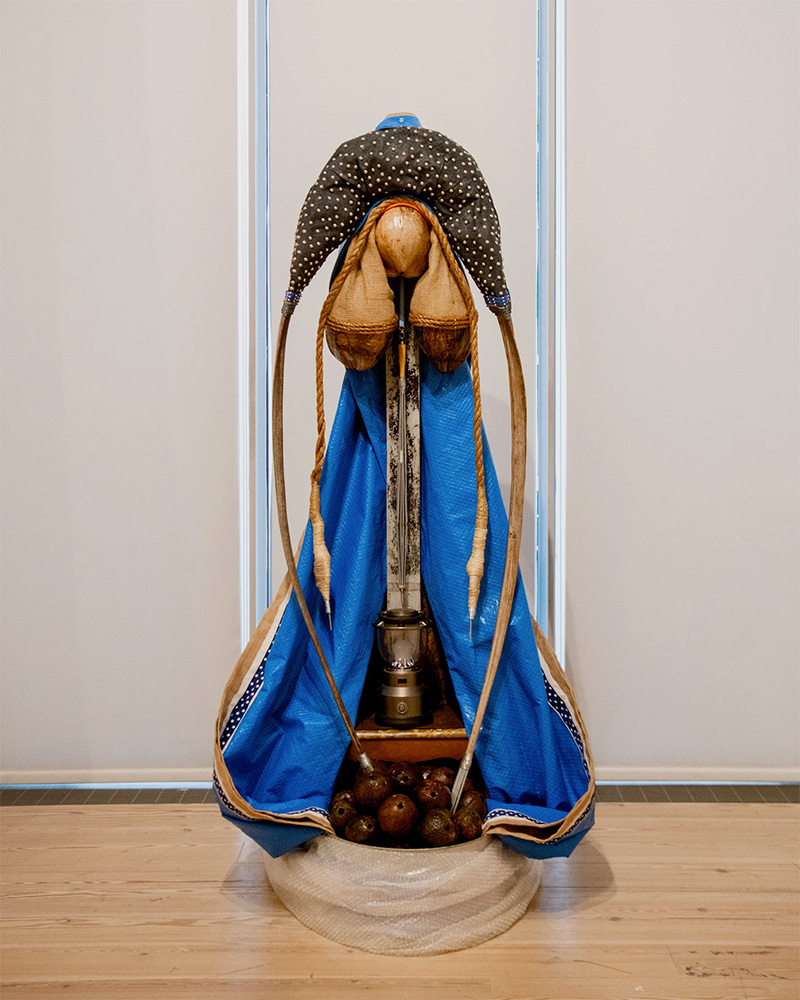
Daniel Lind-Ramos’s “Maria-Maria” (2019) creates, from wood, beads, coconuts and a blue FEMA tarp, a figure that is both the Virgin Mary and the personification of the hurricane that devastated the island in 2017. Vincent Tullo for The New York Times
For a handful of artists, to reclaim history is to reassert the power of spirituality. And the acknowledgment of this element, generally shunned by the market-centered contemporary art world, may be the exhibition’s one truly radical move. In a sculpture titled “Maria-Maria,” the Afro-Puerto Rican artist Daniel Lind-Ramos creates, from wood, beads, coconuts and a blue FEMA tarp, a figure that is both the Virgin Mary and personification of the hurricane that devastated the island in 2017. Enshrined in a sixth floor Whitney window, the piece looks presidingly majestic.
And in a mixed-media installation called “I prayed to the wrong god for you,” the Philadelphia-based artist Tiona Nekkia McClodden records her own experience as a devotee and priestess of the Afro-Cuban religion Santeria, a spiritual practice that led to her carving, in honor of the god Shango, a set of symbolic sculptural tools which she carried on pilgrimage from the United States to Cuba and Nigeria.
Varieties of Sculpture
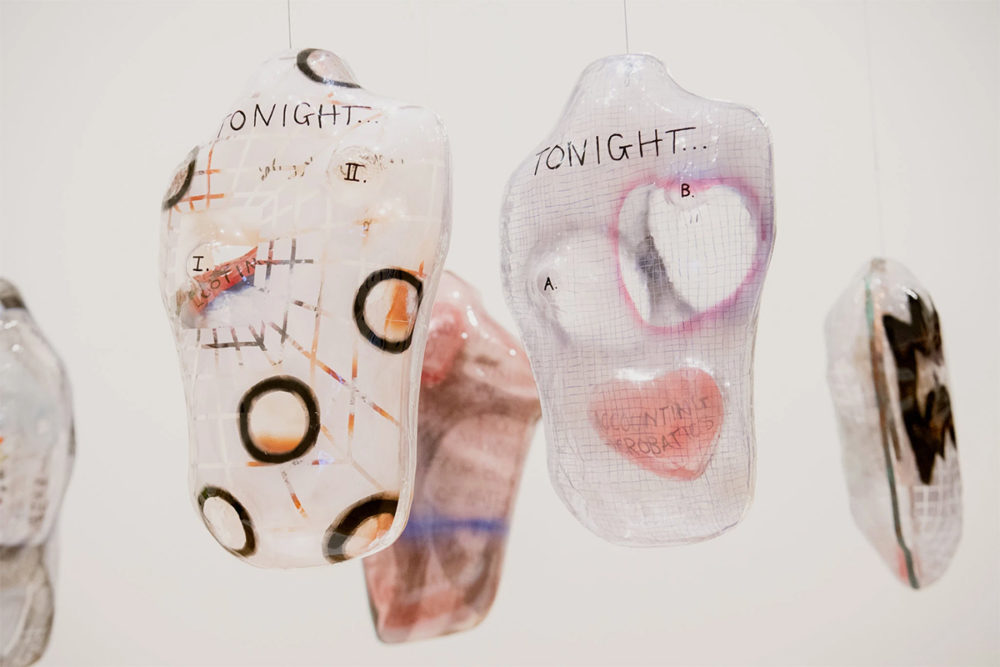
Ragen Moss’s “Romanettes (with double hearts),” 2018. Vincent Tullo for The New York Times
If the Biennial can be said to favor one medium, it’s sculpture, which is enjoying robust health on the evidence of the selection here, ranging from Robert Bittenbender’s trash-and-treasure-infested wire snarls, to Ragen Moss’s polyethylene biomorphs, to attenuated figures, made in Nairobi and New York, by Wangechi Mutu, and ground-hugging ones by the 2018 Hugo Boss Prize winner Simone Leigh.
The ghost of many global modernisms filter through this art and concentrate, with panache, in the sculpture of the Chicago artist Diane Simpson. Ms. Simpson, who is now 84, has been awarded a solo showcase in the Whitney’s lobby gallery. Her work, inspired by architectural design and clothing construction, is basically drawing brought into the third dimension. And, scaled to the human figure, it suggest a new kind of armor, soft but firm, protective but assertive. Rigorous in concept, faultless in execution, her art is sublime in a way no one else’s is.
Sublime is certainly not a word I’d use for the excellences of Nicole Eisenman’s sculptural contribution. Spectacular is, particularly in the context of this anti-spectacle Biennial. Installed on the sixth floor terrace over the High Line, her shambolic tableaus of lurching figures in plaster, metal and Fiberglass embody the exhibition’s history-conjuring, identity-expanding, form-scrambling tendencies, and projects them loud, with a rude anarchic belch of a kind that’s otherwise missing from the show.
There’s nothing illustratively political, or even topical, about the grotesque, flatulent figures (watch for periodic emissions of smoke) in Ms. Eisenman’s sculptural groups, tones titled “Museum Piece con Gas,” another “Man at the Center of Men.” But if you loaded them onto a flatbed truck and paraded them through Washington, their insult-comic outlandishness could shout down any Presidential contender.

